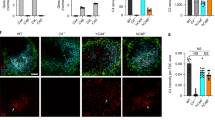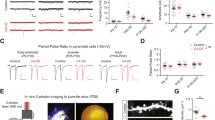Abstract
NEURAL-CELL adhesion molecules (N-CAMs) are members of the immunoglobulin superfamily mediating homo- and heterophilic cell-cell interactions. N-CAM exists in various isoforms which are generated by alternative splicing1–3. During embryonic development, N-CAMs are expressed in derivatives of all three germ layers, whereas in the adult animal they are predominantly present in neural tissue. Processes like neurulation4, axonal outgrowth5, histogenesis of the retina6,7 and development of the olfactory system8–10 are correlated with the regulated expression of N-CAMs11–14. We show here that N-CAM-deficient mice generated by gene targeting appear healthy and fertile, but adult mutants show a 10% reduction in overall brain weight and a 36% decline in size of the olfactory bulb. N-CAM deficiency coincides with almost total loss of protein-bound α-(2,8)-linked polysialic acid, a carbohydrate structure thought to be correlated with neural development and plasticity15,16. The animals showed deficits in spatial learning when tested in the Morris water maze17, whereas activity and motor abilities appeared normal.
This is a preview of subscription content, access via your institution
Access options
Subscribe to this journal
Receive 51 print issues and online access
$199.00 per year
only $3.90 per issue
Buy this article
- Purchase on Springer Link
- Instant access to full article PDF
Prices may be subject to local taxes which are calculated during checkout
Similar content being viewed by others
References
Hemperly, J. J., Murray, B. A., Edelman, G. M. & Cunningham, B. A. Proc. natn. Acad. Sci. U.S.A. 83, 3037–3041 (1986).
Barthels, D. et al. EMBO J. 6, 907–914 (1987).
Barthels, D., Vopper, G., Boned, A., Cremer, H. & Wille, W. Eur. J. Neurosci. 4, 327–337 (1992).
Crossin, K. L., Prieto, A. L., Hoffmann, S., Jones, F. & Friedlander, D. R. Expl Neurol. 109, 6–18 (1990).
Tosney, K. W., Watanabe, M., Landmesser, L. & Rutishauser, U. Devl Biol. 114, 437–452 (1986).
Thiery, J.-P., Brackenbury, R., Rutishauser, U. & Edelman, G. M. J. biol. Chem. 252, 6841–6845 (1977).
Silver, J. & Rutishauser, U. Devl Biol. 106, 485–499 (1984).
Key, B. & Akeson, R. A. J. Cell Biol. 110, 1729–1743 (1990).
Key, B. & Akeson, R. A. Neuron 6, 381–396 (1991).
Chung, W. W., Lagenaur, C. F., Yimin, Y. & Lund, J. S. J. comp. Neurol. 314, 290–305 (1991).
Edelman, G. M. Biochemistry 27, 3534–3543 (1988).
Jessell, T. M. Neuron 1, 3–13 (1990).
Rutishauser, U. & Jessel, T. M. Physiol. Rev. 68, 819–857 (1988).
Goridis, C. & Brunet, J.-F. Semin. Cell Biol. 3, 189–197 (1992).
Theodosis, D. T., Rougon, G. & Poulain, D. A. Proc. natn. Acad. Sci. U.S.A. 88, 5494–5498 (1991).
Seki, T. & Arai, Y. Neurosci. Res. 12, 503–513 (1991).
Morris, R. G. M. Learning Motivation 12, 239–260 (1981).
Mansour, S. L., Thomas, K. R. & Capecci, M. R. Nature 336, 348–352 (1988).
Goldowitz, D., Barthels, D., Lorenzon, N., Jungblut, A. & Wille, W. Devl Brain Res. 52, 151–160 (1990).
Zuber, C., Lackie, P. M., Catterall, W. A. & Roth, J. J. biol. Chem. 267, 9965–9971 (1992).
Thiel, G. Brain Path. 3, 87–95 (1993).
Rutishauser, U., Acheson, A., Hall, A. K., Mann, D. M. & Sunshine, J. Science 240, 53–57 (1988).
Breipohl, W., Mackay-Sim, A., Grandt, D., Rehn, D. & Darrelmann, C. in Ontogeny of Olfaction (ed. Breipohl, W.) 21–34 (Springer, New York, 1986).
Daniloff, J. K., Levi, G., Grumet, M., Rieger, F. & Edelman, G. M. J. Cell Biol. 103, 929–945 (1986).
Cornwell-Jones, C. Behavl Biol. 17, 131–137 (1976).
Schorley, A. B., Rose, S. P. R., Zamani, M. R., Bock, E. & Schachner, M. Neuroscience 55, 499–509 (1993).
Mayford, M., Barzilai, A., Keller, F., Schacher, S. & Kandel, E. R. Science 256, 638–649 (1992).
Schenk, E. & Morris, R. G. M. Expl Brain Res. 58, 11–28 (1985).
Silva, A. J., Paylor, R., Wehner, J. & Tonegawa, S. Science 257, 206–211 (1992).
Grant, S. G. N. et al. Science 258, 1903–1910 (1992).
Author information
Authors and Affiliations
Rights and permissions
About this article
Cite this article
Cremer, H., Lange, R., Christoph, A. et al. Inactivation of the N-CAM gene in mice results in size reduction of the olfactory bulb and deficits in spatial learning. Nature 367, 455–459 (1994). https://doi.org/10.1038/367455a0
Received:
Accepted:
Issue Date:
DOI: https://doi.org/10.1038/367455a0
This article is cited by
-
Neuroimmunomodulatory properties of polysialic acid
Glycoconjugate Journal (2023)
-
Interactions between polysialic acid and dopamine-lead compounds as revealed by biochemical and in silico docking simulation analyses
Glycoconjugate Journal (2023)
-
Neural glycomics: the sweet side of nervous system functions
Cellular and Molecular Life Sciences (2021)
-
The cell adhesion protein CAR is a negative regulator of synaptic transmission
Scientific Reports (2019)
-
Development of new method to enrich human iPSC-derived renal progenitors using cell surface markers
Scientific Reports (2018)
Comments
By submitting a comment you agree to abide by our Terms and Community Guidelines. If you find something abusive or that does not comply with our terms or guidelines please flag it as inappropriate.



